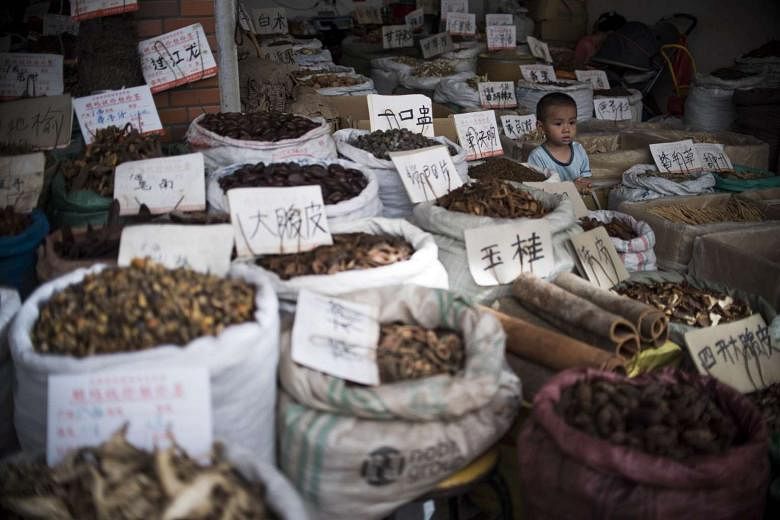By Wen Zongduo
China Daily/Asia News Network
The Western world should learn to appreciate the value of the treasures of traditional Chinese medicine.
Although Tu Youyou, a winner of the 2015 Nobel Prize in Physiology or Medicine, was applauded in Stockholm when the Chinese pharmacologist declared that "the discovery of artemisinin is a gift to mankind from Traditional Chinese Medicine"; not all agreed with her view.
Even some at home pointed out Tu and her team used bio-chemical means to extract the active artemisinin from sweet wormwood half a century ago.
Yet Tu's inspiration is deeply rooted in thousands of years of TCM practice. The book that inspired her work, Handbook of Prescriptions for Emergencies (Zhouhou Beiji Fang), can be dated back to at least the Han Dynasty (206 BC-AD 220).
Although the traditional way of using these treatments has benefited Chinese for long, the processing highlighted by the Nobel prize carries its own advantages in prescription, actual taking of the medicine and logistic services. Further exploration offers abundant opportunities.
The earliest book of Chinese herbs, The Divine Farmer's Classic on Roots and Herbs (Shennong Bencao Jing) cites 365 kinds of herbs including sweet wormwood.
These are a gold mine for Chinese and multinational drug developers, which can be exploited to benefit millions of people.
In fact, apart from treating viruses, TCM has been most effective in predicting diseases, cultivating fitness, treating chronic, difficult, multi-source illnesses, and using non-medicinal methods such as acupuncture and breathing exercises.
Its theories of yin and yang, the five elements, jingluo cycles (meridian channels) and pulse feelings have been encapsulated in many popular Chinese sayings and idioms over the centuries.
One saying, "Treating the head in case of headache and the feet in case of foot-ache" refers not only to sub-par doctors but also ineffective problem-solving without tracing the root causes.
Many Chinese cancer patients are living comparatively fulfilling lives after TCM treatment, despite being declared terminally ill by Western-style hospitals.
And the saying, "treat not the tumor after seeing a tumor", reflects the holistic perception of TCM which upholds the principle of diagnosis and treatment on the basis of differentiating symptoms from a person's overall condition.
What is common sense for ordinary Chinese is not excluded from the acceptance of experts and professionals in the West as long as they free their minds of skepticism and prejudice.
The differences in approaches are fundamental. In the West, the term health often means bodily statistics within a normal range, but in TCM it means the sustainable condition of a healthy human body.
Western medicine believes in using surgery and chemical or biological compounds to remove and eliminate abnormal symptoms, the very target of its approach.
TCM takes the healthy body as a balanced and well-coordinated whole, not only among its own parts but also with the living environment.
In this sense the human body may be seen as a supercomputer with the body parts as the hardware and the jingluo cycles as its operational software, all powered and orchestrated by the circulation of blood and qi (life energy force) through the body.
In treating sickness, TCM tends to cultivate and stimulate the circulations of blood and qi, so that the body revives its own energy for the inner physic systems to self-repair and recuperate.
When the gums flare up, Western-style dentists usually diagnose and handle it as gingivitis or periodontitis.
Yet a TCM doctor may see it as related to a problem with the large intestine, and further with the poor circulation of the body's blood and qi.
It is common to see elderly patients take home dozens of kinds of medicine for multiple diseases from several hospital divisions after a Western-style check-up and treatment.
Yet a TCM doctor will likely prescribe a certain compound of herbs for all the symptoms with minor adjustments later depending on the changes in a patient's condition.
The approaches and methods of TCM may seem strange to many in the Western world; but the de facto primer of TCM, The Inner Classic of the Yellow Emperor (Huangdi Neijing), was written thousands of years ago, long before the establishment of many fields of Western medicine.
The TCM methods thus derived have proven feasible and effective and deserve global reflections on their more widespread use.
Once checked closely without distorted lenses, TCM is easily accessible, ready to welcome outsiders, pleasant to apply and generous in its rewards to both health and the industry.

